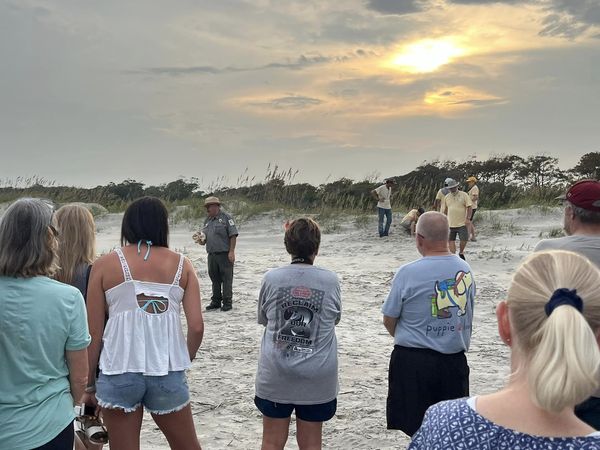Introduction
Huntington Beach State Park in South Carolina is not just a haven for beach lovers—it’s also a wildlife enthusiast’s dream come true. With its diverse habitats ranging from salt marshes to hardwood swamps, the park offers countless opportunities for memorable wildlife encounters. Whether you’re a seasoned nature lover or just looking for a family-friendly adventure, the park’s wildlife provides a fascinating glimpse into the area’s natural beauty. In this article, we’ll explore the top five wildlife encounters that you absolutely shouldn’t miss when visiting Huntington Beach State Park.

The Majestic American Alligator
The American alligator, often dubbed as the “King of the Marsh,” is a sight to behold. These prehistoric-looking reptiles can be seen lounging in the park’s wetlands and lagoons. Their powerful tails and rough, scaly skin make them stand out against the backdrop of lush vegetation.
Best spots to see them: The Salt Marsh Trail and the boardwalk leading to the park’s observation tower are great places to spot these magnificent creatures. They prefer basking in the sun, so early morning or late afternoon provides the best opportunities for sightings.
Safety tips for viewing: While it’s thrilling to see an alligator in its natural habitat, it’s crucial to maintain a safe distance. Never approach or feed them, and always keep a respectful distance to avoid any potential dangers.
The Colorful Roseate Spoonbill
With their vibrant pink feathers and unique spoon-shaped bills, Roseate spoonbills are a feast for the eyes. These stunning birds add a splash of color to the park’s scenery and are a highlight for bird watchers.
Where to find them: Look for these beauties in the park’s salt marshes and tidal flats. The areas around the Nature Center and the Murrells Inlet are particularly good for spotting them.
Best times for observation: Early morning or late afternoon is ideal when the birds are most active. Their bright colors are especially striking against the softer light of dawn or dusk.
The Graceful Osprey
The osprey, also known as the “sea hawk,” is renowned for its impressive fishing skills. With its white underbelly and striking dark eyes, it’s easy to spot as it soars above or nests in the park’s tall trees.
Nesting areas in the park: The trees along the park’s waterways, particularly near the boardwalks and salt marshes, are prime locations to spot ospreys. Look for their large nests perched high up, often built on man-made structures like poles or platforms.
Tips for spotting: Bring binoculars to get a closer look at these magnificent birds. Their hunting dives are a thrilling sight, showcasing their precision and agility.
The Curious White-tailed Deer
White-tailed deer are a common yet charming sight in Huntington Beach State Park. Their gentle demeanor and elegant movements make them a favorite among visitors.
Places to observe them: These deer are often seen in the park’s wooded areas and open fields. The area around the park’s freshwater lagoons and the forested trails provides excellent chances for sightings.
Best practices for wildlife interaction: While it’s tempting to approach these graceful animals, it’s important to observe from a distance. Do not feed them, as this can alter their natural behaviors and diet.

The Playful Bottlenose Dolphin
Dolphins are a highlight of any coastal wildlife experience, and Huntington Beach State Park is no exception. Bottlenose dolphins are known for their playful behavior and acrobatic displays.
Best locations for sightings: The park’s oceanfront and beach areas, especially near the jetty and inlet, are ideal spots for dolphin watching. Early mornings and late afternoons are the best times to catch a glimpse of these playful creatures.
Tips for responsible viewing: Keep a safe distance and avoid disturbing their natural activities. Use binoculars or a camera with a zoom lens to capture their playful leaps and spins without getting too close.
How to Make the Most of Your Wildlife Viewing Experience
To fully enjoy your wildlife encounters at Huntington Beach State Park, preparation is key.
Suggested trails and areas: The Salt Marsh Trail, the boardwalks, and the Nature Center are excellent starting points. Each area offers unique perspectives and chances to see different species.
Essential gear and preparation: Bring a pair of binoculars, a camera with a zoom lens, and comfortable walking shoes. A field guide or wildlife app can also enhance your experience by helping you identify various species.
Best times of day and seasons: Early mornings and late afternoons are generally the best times for wildlife viewing. Spring and fall offer milder weather and increased animal activity, making them ideal seasons for a visit.
Conclusion
Huntington Beach State Park is a treasure trove of wildlife encounters waiting to be discovered. From the formidable American alligator to the lively bottlenose dolphin, each species offers a unique glimpse into the park’s rich biodiversity. Whether you’re an avid naturalist or simply looking for a memorable outdoor experience, the park’s wildlife promises to captivate and inspire. So grab your binoculars, head to the trails, and immerse yourself in the wonders of nature at Huntington Beach State Park.
FAQs
What is the best time of year to see wildlife at Huntington Beach State Park?
Spring and fall are the best times to see a variety of wildlife due to mild weather and increased animal activity.
Are there guided tours available for wildlife viewing?
Yes, the park offers guided tours and programs that can enhance your wildlife viewing experience.
Can I bring my dog when looking for wildlife?
Dogs are allowed in some areas of the park, but it’s best to check park regulations and keep them on a leash to avoid disturbing wildlife.
How can I stay safe while observing wildlife?
Maintain a safe distance from animals, do not feed them, and follow park guidelines to ensure both your safety and the well-being of the wildlife.
What should I do if I encounter a wild animal?
Observe from a distance, do not approach or try to feed the animal, and report any concerning behavior to park officials.

